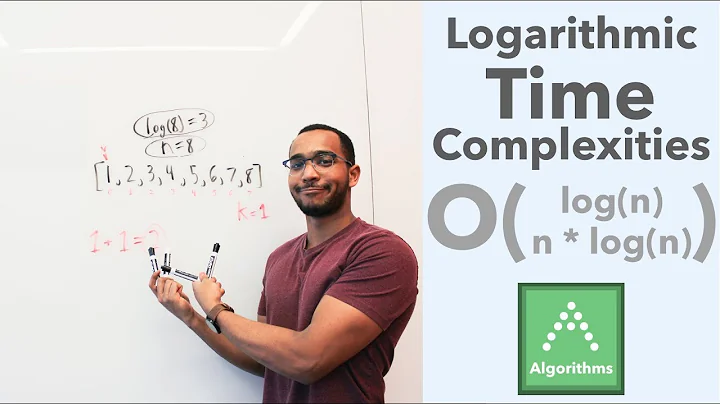What would cause an algorithm to have O(log log n) complexity?
Solution 1
O(log log n) terms can show up in a variety of different places, but there are typically two main routes that will arrive at this runtime.
Shrinking by a Square Root
As mentioned in the answer to the linked question, a common way for an algorithm to have time complexity O(log n) is for that algorithm to work by repeatedly cut the size of the input down by some constant factor on each iteration. If this is the case, the algorithm must terminate after O(log n) iterations, because after doing O(log n) divisions by a constant, the algorithm must shrink the problem size down to 0 or 1. This is why, for example, binary search has complexity O(log n).
Interestingly, there is a similar way of shrinking down the size of a problem that yields runtimes of the form O(log log n). Instead of dividing the input in half at each layer, what happens if we take the square root of the size at each layer?
For example, let's take the number 65,536. How many times do we have to divide this by 2 until we get down to 1? If we do this, we get
- 65,536 / 2 = 32,768
- 32,768 / 2 = 16,384
- 16,384 / 2 = 8,192
- 8,192 / 2 = 4,096
- 4,096 / 2 = 2,048
- 2,048 / 2 = 1,024
- 1,024 / 2 = 512
- 512 / 2 = 256
- 256 / 2 = 128
- 128 / 2 = 64
- 64 / 2 = 32
- 32 / 2 = 16
- 16 / 2 = 8
- 8 / 2 = 4
- 4 / 2 = 2
- 2 / 2 = 1
This process takes 16 steps, and it's also the case that 65,536 = 216.
But, if we take the square root at each level, we get
- √65,536 = 256
- √256 = 16
- √16 = 4
- √4 = 2
Notice that it only takes four steps to get all the way down to 2. Why is this?
First, an intuitive explanation. How many digits are there in the numbers n and √n? There are approximately log n digits in the number n, and approximately log (√n) = log (n1/2) = (1/2) log n digits in √n. This means that, each time you take a square root, you're roughly halving the number of digits in the number. Because you can only halve a quantity k O(log k) times before it drops down to a constant (say, 2), this means you can only take square roots O(log log n) times before you've reduced the number down to some constant (say, 2).
Now, let's do some math to make this rigorous. Le'ts rewrite the above sequence in terms of powers of two:
- √65,536 = √216 = (216)1/2 = 28 = 256
- √256 = √28 = (28)1/2 = 24 = 16
- √16 = √24 = (24)1/2 = 22 = 4
- √4 = √22 = (22)1/2 = 21 = 2
Notice that we followed the sequence 216 → 28 → 24 → 22 → 21. On each iteration, we cut the exponent of the power of two in half. That's interesting, because this connects back to what we already know - you can only divide the number k in half O(log k) times before it drops to zero.
So take any number n and write it as n = 2k. Each time you take the square root of n, you halve the exponent in this equation. Therefore, there can be only O(log k) square roots applied before k drops to 1 or lower (in which case n drops to 2 or lower). Since n = 2k, this means that k = log2 n, and therefore the number of square roots taken is O(log k) = O(log log n). Therefore, if there is algorithm that works by repeatedly reducing the problem to a subproblem of size that is the square root of the original problem size, that algorithm will terminate after O(log log n) steps.
One real-world example of this is the van Emde Boas tree (vEB-tree) data structure. A vEB-tree is a specialized data structure for storing integers in the range 0 ... N - 1. It works as follows: the root node of the tree has √N pointers in it, splitting the range 0 ... N - 1 into √N buckets each holding a range of roughly √N integers. These buckets are then each internally subdivided into √(√ N) buckets, each of which holds roughly √(√ N) elements. To traverse the tree, you start at the root, determine which bucket you belong to, then recursively continue in the appropriate subtree. Due to the way the vEB-tree is structured, you can determine in O(1) time which subtree to descend into, and so after O(log log N) steps you will reach the bottom of the tree. Accordingly, lookups in a vEB-tree take time only O(log log N).
Another example is the Hopcroft-Fortune closest pair of points algorithm. This algorithm attempts to find the two closest points in a collection of 2D points. It works by creating a grid of buckets and distributing the points into those buckets. If at any point in the algorithm a bucket is found that has more than √N points in it, the algorithm recursively processes that bucket. The maximum depth of the recursion is therefore O(log log n), and using an analysis of the recursion tree it can be shown that each layer in the tree does O(n) work. Therefore, the total runtime of the algorithm is O(n log log n).
O(log n) Algorithms on Small Inputs
There are some other algorithms that achieve O(log log n) runtimes by using algorithms like binary search on objects of size O(log n). For example, the x-fast trie data structure performs a binary search over the layers of at tree of height O(log U), so the runtime for some of its operations are O(log log U). The related y-fast trie gets some of its O(log log U) runtimes by maintaining balanced BSTs of O(log U) nodes each, allowing searches in those trees to run in time O(log log U). The tango tree and related multisplay tree data structures end up with an O(log log n) term in their analyses because they maintain trees that contain O(log n) items each.
Other Examples
Other algorithms achieve runtime O(log log n) in other ways. Interpolation search has expected runtime O(log log n) to find a number in a sorted array, but the analysis is fairly involved. Ultimately, the analysis works by showing that the number of iterations is equal to the number k such that n2-k ≤ 2, for which log log n is the correct solution. Some algorithms, like the Cheriton-Tarjan MST algorithm, arrive at a runtime involving O(log log n) by solving a complex constrained optimization problem.
Hope this helps!
Solution 2
One way to see factor of O(log log n) in time complexity is by division like stuff explained in the other answer, but there is another way to see this factor, when we want to make a trade of between time and space/time and approximation/time and hardness/... of algorithms and we have some artificial iteration on our algorithm.
For example SSSP(Single source shortest path) has an O(n) algorithm on planar graphs, but before that complicated algorithm there was a much more easier algorithm (but still rather hard) with running time O(n log log n), the base of algorithm is as follow (just very rough description, and I'd offer to skip understanding this part and read the other part of the answer):
- divide graph into the parts of size O(log n/(log log n)) with some restriction.
- Suppose each of mentioned part is node in the new graph G' then compute SSSP for G' in time O(|G'|*log |G'|) ==> here because |G'| = O(|G|*log log n/log n) we can see the (log log n) factor.
- Compute SSSP for each part: again because we have O(|G'|) part and we can compute SSSP for all parts in time |n/logn| * |log n/log logn * log (logn /log log n).
- update weights, this part can be done in O(n). for more details this lecture notes are good.
But my point is, here we choose the division to be of size O(log n/(log log n)). If we choose other divisions like O(log n/ (log log n)^2) which may runs faster and brings another result. I mean, in many cases (like in approximation algorithms or randomized algorithms, or algorithms like SSSP as above), when we iterate over something (subproblems, possible solutions, ...), we choose number of iteration corresponding to the trade of that we have (time/space/complexity of algorithm/ constant factor of the algorithm,...). So may be we see more complicated stuffs than "log log n" in real working algorithms.
Related videos on Youtube
templatetypedef
I love teaching, learning, and that really great feeling you get when you finally understand something.
Updated on July 30, 2020Comments
-
templatetypedef almost 4 years
This earlier question addresses some of the factors that might cause an algorithm to have O(log n) complexity.
What would cause an algorithm to have time complexity O(log log n)?
-
templatetypedef almost 11 years@JonathonReinhart- This just happened to be something I thought was (a) really, really cool, and (b) not well known. I'm always glad to share things like this! :-)
-
templatetypedef over 8 years@Mahesha999 Stack Overflow actively encourages users to answer their own questions. :-)
-
Mahesha999 over 8 yearsjust guessing what other implications "Answer your own question" at the bottom of the Ask Question page might be having or it just enables answer textbox on question page.
-
Gun2sh almost 7 yearsImportant line: Therefore, if there is algorithm that works by repeatedly reducing the problem to a subproblem of size that is the square root of the original problem size, that algorithm will terminate after O(log log n) steps.




![Big O Notation Series #10: Log n Complexity Explained With An Iterative Function [Logarithmic time]](https://i.ytimg.com/vi/SfygqfMVSgw/hq720.jpg?sqp=-oaymwEcCNAFEJQDSFXyq4qpAw4IARUAAIhCGAFwAcABBg==&rs=AOn4CLDI9ZxK-AnCyndbaT4tvOy46iqEfQ)